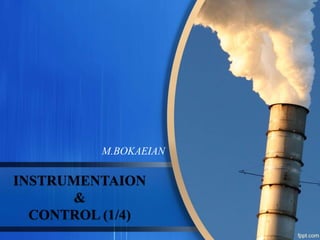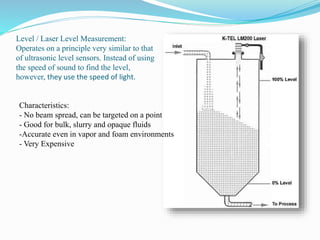The document provides information on various types of instrumentation and control variables including pressure, temperature, and flow. It describes different sensor types for measuring each variable, including manometers, bourdon tubes, bellows, diaphragms, piezoelectric sensors, RTDs, thermocouples, thermistors, optical sensors, orifice plates, venturi tubes, vortex shedding, and turbine flow meters. For each sensor type, it discusses the measurement principle, advantages, disadvantages, and applications.



















![Temperature:
Is a comparative objective measurement of hot and cold.
Sensors of
Temperature
Measurement
Thermocouple (TC)
Resistance Temperature Detector (RTD) (TE)
Bimetal
Filled Thermal Systems
Optical
Unit From Celsius To Celsius
Fahrenheit [F°] = [C°] × 9⁄5 + 32 [C°] = ([F°] − 32) × 5⁄9
Kelvin [K°] = [C°] + 273.15 [C°] = [K°] − 273.15
Thermistor
IC Sensors](https://image.slidesharecdn.com/instrumentation-measurementprinciples-151107112531-lva1-app6891/85/Instrumentation-measurement-principles-20-320.jpg)























































